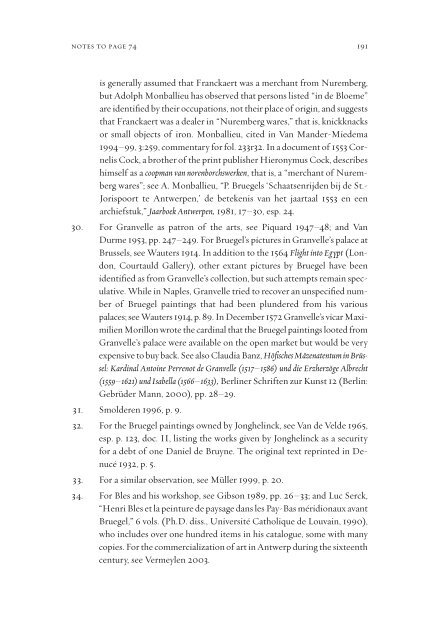Pieter Bruegel and the Art of Laughter - AAAARG.ORG
Pieter Bruegel and the Art of Laughter - AAAARG.ORG
Pieter Bruegel and the Art of Laughter - AAAARG.ORG
Create successful ePaper yourself
Turn your PDF publications into a flip-book with our unique Google optimized e-Paper software.
notes to page 74 191<br />
is generally assumed that Franckaert was a merchant from Nuremberg,<br />
but Adolph Monballieu has observed that persons listed “in de Bloeme”<br />
are identified by <strong>the</strong>ir occupations, not <strong>the</strong>ir place <strong>of</strong> origin, <strong>and</strong> suggests<br />
that Franckaert was a dealer in “Nuremberg wares,” that is, knickknacks<br />
or small objects <strong>of</strong> iron. Monballieu, cited in Van M<strong>and</strong>er-Miedema<br />
1994–99, 3:259, commentary for fol. 233r32. In a document <strong>of</strong> 1553 Cornelis<br />
Cock, a bro<strong>the</strong>r <strong>of</strong> <strong>the</strong> print publisher Hieronymus Cock, describes<br />
himself as a coopman van norenborchswerken, that is, a “merchant <strong>of</strong> Nuremberg<br />
wares”; see A. Monballieu, “P. <strong>Bruegel</strong>s ‘Schaatsenrijden bij de St.-<br />
Jorispoort te Antwerpen,’ de betekenis van het jaartaal 1553 en een<br />
archiefstuk,” Jaarboek Antwerpen, 1981, 17–30, esp. 24.<br />
30. For Granvelle as patron <strong>of</strong> <strong>the</strong> arts, see Piquard 1947–48; <strong>and</strong> Van<br />
Durme 1953, pp. 247–249. For <strong>Bruegel</strong>’s pictures in Granvelle’s palace at<br />
Brussels, see Wauters 1914. In addition to <strong>the</strong> 1564 Flight into Egypt (London,<br />
Courtauld Gallery), o<strong>the</strong>r extant pictures by <strong>Bruegel</strong> have been<br />
identified as from Granvelle’s collection, but such attempts remain speculative.<br />
While in Naples, Granvelle tried to recover an unspecified number<br />
<strong>of</strong> <strong>Bruegel</strong> paintings that had been plundered from his various<br />
palaces; see Wauters 1914, p. 89. In December 1572 Granvelle’s vicar Maximilien<br />
Morillon wrote <strong>the</strong> cardinal that <strong>the</strong> <strong>Bruegel</strong> paintings looted from<br />
Granvelle’s palace were available on <strong>the</strong> open market but would be very<br />
expensive to buy back. See also Claudia Banz, Höfisches Mäzenatentum in Brüssel:<br />
Kardinal Antoine Perrenot de Granvelle (1517–1586) und die Erzherzöge Albrecht<br />
(1559–1621) und Isabella (1566–1633), Berliner Schriften zur Kunst 12 (Berlin:<br />
Gebrüder Mann, 2000), pp. 28–29.<br />
31. Smolderen 1996, p. 9.<br />
32. For <strong>the</strong> <strong>Bruegel</strong> paintings owned by Jonghelinck, see Van de Velde 1965,<br />
esp. p. 123, doc. II, listing <strong>the</strong> works given by Jonghelinck as a security<br />
for a debt <strong>of</strong> one Daniel de Bruyne. The original text reprinted in Denucé<br />
1932, p. 5.<br />
33. For a similar observation, see Müller 1999, p. 20.<br />
34. For Bles <strong>and</strong> his workshop, see Gibson 1989, pp. 26–33; <strong>and</strong> Luc Serck,<br />
“Henri Bles et la peinture de paysage dans les Pay-Bas méridionaux avant<br />
<strong>Bruegel</strong>,” 6 vols. (Ph.D. diss., Université Catholique de Louvain, 1990),<br />
who includes over one hundred items in his catalogue, some with many<br />
copies. For <strong>the</strong> commercialization <strong>of</strong> art in Antwerp during <strong>the</strong> sixteenth<br />
century, see Vermeylen 2003.












